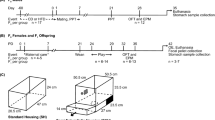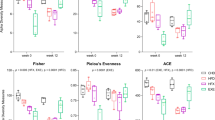Abstract
Objective:
Microbial manipulations in early life can affect gut development and inflammatory status of the neonate. The maternal diet during pregnancy and lactation also influences the health of the offspring, but the impact of maternal high-fat (HF) feeding along with modulations of the gut microbiota on body weight, fat deposition and gut function in the offspring has been poorly studied.
Methods:
Rat dams were given access to either an HF or a standard low-fat diet during the last 2 weeks of pregnancy and during lactation and effects on body weight and gastrointestinal function were investigated in the 14-day-old offspring. To elucidate whether bacterial administration to the dam could modulate any effects of the diets in the rat pups, another group of dams were given Escherichia coli in their drinking water.
Results:
Maternal HF feeding resulted in increased body and fat pad weights in the offspring, along with increased levels of the acute-phase protein, haptoglobin and decreased protein content and disaccharidase activities in the small intestine. The addition of E. coli further accentuated these responses in the young rats, which, in addition to higher body weights and increased fat deposition, also showed an increased intestinal permeability and elevated levels of haptoglobin.
Conclusions:
The present study demonstrates for the first time how bacterial administration to the maternal diet during the neonatal period can affect body weight and fat deposition in the offspring. The results point to a mechanistic link between the gut microbiota, increased intestinal permeability and metabolic endotoxemia, which appear to have led to increased adiposity in the young rats.
This is a preview of subscription content, access via your institution
Access options
Subscribe to this journal
Receive 12 print issues and online access
$259.00 per year
only $21.58 per issue
Buy this article
- Purchase on SpringerLink
- Instant access to full article PDF
Prices may be subject to local taxes which are calculated during checkout



Similar content being viewed by others
References
Bäckhed F, Manchester J, Semenkovich C, Gordon J . Mechanisms underlying the resistance to diet-induced obesity in germ-free mice. PNAS 2007; 104: 979–984.
Ley R, Turnbaugh P, Klein S, Gordon J . Microbial ecology: human gut microbes associated with obesity. Nature 2006; 444: 1022–1023.
Turnbaugh P, Ley R, Mahowald M, Magrini V, Mardis E, Gordon J . An obesity-associated gut microbiome with increased capacity for energy harvest. Nature 2006; 444: 1027–1031.
Fåk F, Ahrné S, Linderoth A, Molin G, Jeppsson B, Weström B . Age-related effects of the probiotic bacterium lactobacillus plantarum 299v on gastrointestinal function in suckling rats. Dig Dis Sci 2008; 53: 664–671.
Fåk F, Ahrné S, Molin G, Jeppsson B, Weström B . Microbial manipulation of the rat dam changes bacterial colonization and alters properties of the gut in her offspring. Am J Physiol Gastrointest Liver Physiol 2008; 294: G148–G154.
Symonds M . Integration of physiological and molecular mechanisms of the developmental origins of adult disease: new concepts and insights. Proc Nutr Soc 2007; 66: 442–450.
Taylor P, Poston L . Developmental programming of obesity in mammals. Exp Physiol 2007; 92: 287–298.
Castillo R, Feng J, Stevenson D, Kerner J, Kwong L . Regulation of intestinal ontogeny by intraluminal nutrients. J Pediatr Gastroenterol Nutr 1990; 10: 199–205.
Walthall K, Cappon G, Hurtt M, Zoetis T . Postnatal development of the gastrointestinal system: a species comparison. Birth Defects Res 2005; 74: 132–156.
Pacha J . Development of intestinal transport function in mammals. Physiol Rev 2000; 80: 1633–1667.
Telemo E, Westrom B, Ekström G, Karlsson B . Intestinal macromolecular transmission in the young rat: influence of protease inhibitors during development. Biol Neonate 1987; 52: 141–148.
Mozes S, Sefcikova Z, Lenhardt L . Functional changes in the small intestine in over- and undernourished suckling rats support the development of obesity risk on a high-energy diet in later life. Physiol Res 1997; 56: 183–192.
Perin N, Jarocka-Cyrta E, Keelan M, Clandinin T, Thomson A . Dietary lipid composition modifies intestinal morphology and nutrient transport in young rats. J Pediatr Gastroenterol Nutr 1999; 28: 46–53.
Buckley A, Keseru B, Briody J, Thompson M, Ozanne S, Thompson C . Altered body composition and metabolism in the male offspring of high fat-fed rats. Metabolism 2005; 54: 500–507.
Srinivasan M, Katewa S, Palaniyappan A, Pandya J, Patel M . Maternal high-fat diet consumption results in fetal malprogramming predesposing to the onset of metabolic syndrome-like phenotype in adulthood. Am J Physiol Endocrinol Metabol 2006; 291: 792–799.
Giffen P, Turton J, Andrews C, Barrett P, Clarke CJ, Fung KW et al. Markers of experimental acute inflammation in the Wistar Han rat with particular reference to haptoglobin and C-reactive protein. Arch Toxicol 2003; 77: 392–402.
Hoene M, Weigert C . The role of interleukin-6 in insulin resistance, body fat distribution and energy balance. Obes Rev 2008; 9: 20–29.
Dahlqvist A . Assay of intestinal disaccharidases. Scand J Clin Lab Invest 1984; 44: 169–172.
Lowry O, Rosebrough N, Farr A, Randall R . Protein measurements with folin phenol reagent. J Biol Chem 1951; 193: 265–275.
Laurell C . Electroimmunoassay. Scand J Clin Lab Invest 1972; 124: 21–37.
Santacruz A, Collado M, García-Valdés L, Segura MT, Martín-Lagos JA, Anjos T et al. Gut microbiota composition is associated with body weight, weight gain and biochemical parameters in pregnant women. Br J Nutr 2010; 104: 83–92.
Cani P, Amar J, Iglesias M, Poggi M, Knauf C, Bastelica D et al. Metabolic endotoxemia initiates obesity and insulin resistance. Diabetes 2007; 56: 1761–1772.
Dickerson RN, Karwoski CB . Endotoxin-mediated hepatic lipid accumulation during parenteral nutrition in rats. J Am College Nutr 2002; 21: 351–356.
Acknowledgements
We thank Mrs Camilla Björklöv for excellent analyses of the intestinal permeability and pancreatic enzymology and for animal care. We also thank Dr Fredrik Bäckhed for critical reading of the manuscript and useful comments. The Swedish research council Formas (Grant 2004-808-2545-30), the Direktör Albert Påhlsson Foundation and the Johanna Andersson Foundation are greatly acknowledged for financial support.
Author information
Authors and Affiliations
Corresponding author
Ethics declarations
Competing interests
The authors declare no conflict of interest.
Additional information
Author contributions
FF designed and carried out the studies and involved in data analyses and drafted the manuscript. CK designed and carried out the studies, involved in part of the data analyses and revised the manuscript. SA, GM and BW participated in the study design, interpreted the data and revised the manuscript. All authors read and approved the final manuscript.
Rights and permissions
About this article
Cite this article
Fåk, F., Karlsson, C., Ahrné, S. et al. Effects of a high-fat diet during pregnancy and lactation are modulated by E. coli in rat offspring. Int J Obes 36, 744–751 (2012). https://doi.org/10.1038/ijo.2011.118
Received:
Revised:
Accepted:
Published:
Issue date:
DOI: https://doi.org/10.1038/ijo.2011.118



